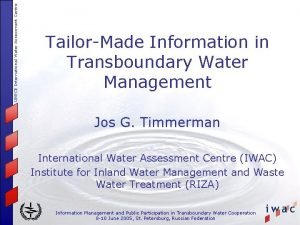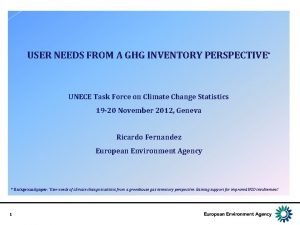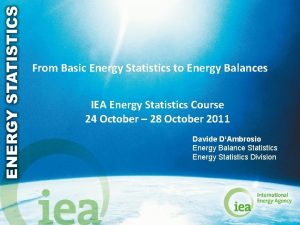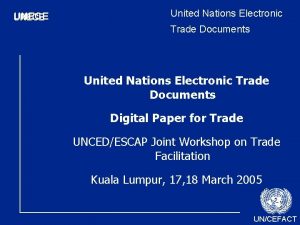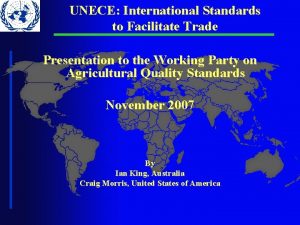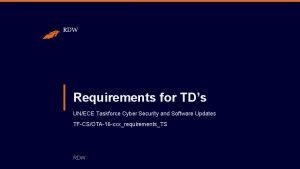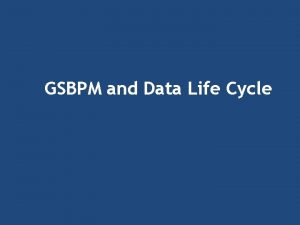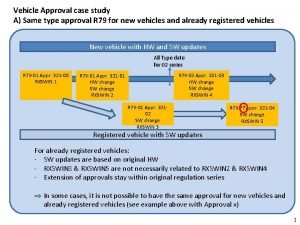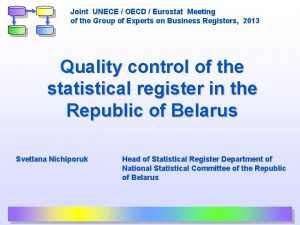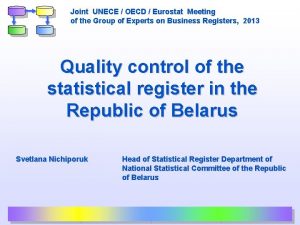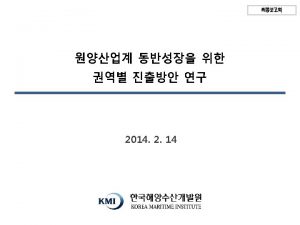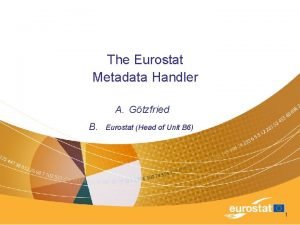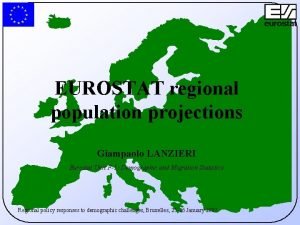Joint UNECE Eurostat OECD Meeting on National Accounts
















- Slides: 16

Joint UNECE / Eurostat / OECD Meeting on National Accounts (Geneva, 25 - 28 April 2006) Item 7: National Accounts And Employment Data Using Employment Statistics in the Russian National Accounts Alexander Surinov Deputy Head of Rosstat

ESTIMATION OF TOTAL LABOR INPUT In accordance with the SNA concept, estimation of total labor input in production of goods and services by all kinds of work is done on the basis of three main measures: ü number of workplaces ü total hours worked ü full-time equivalent employment FEDERAL STATE STATISTICS SERVICE (ROSSTAT)

MEASURES OF TOTAL LABOR INPUT HW = WP x average actual hours worked in the accounting period FTE = HW / average hours worked by full-time employees FTE – number of work-places in full-time equivalent FEDERAL STATE STATISTICS SERVICE (ROSSTAT)

AVERAGE HOURS WORKED BY FULL-TIME EMPLOYEES Average hours worked by full-time employees in the accounting period is determined as the maximum possible number of work hours in case of 40 work hour week with the exclusion of leave time stipulated by legislation in the given period. Maximum possible annual hours worked = 1920 (52 calendar weeks – 4 weeks of leave) x 40 hours FEDERAL STATE STATISTICS SERVICE (ROSSTAT)

OBSERVATION UNITS AND DATA SOURCES TO ESTIMATE TOTAL LABOR INPUTS FEDERAL STATE STATISTICS SERVICE (ROSSTAT)

CONSOLIDATION OF DATA FROM VARIOUS SOURCES Total labor input estimation: stages 1. Analysis of estimates obtained from different sources: • period in question • coverage of employed population • choice of variables 2. Work with primary data: • enterprise survey results • labor force survey results 3. Comparison of data from different sources; data divergence analysis; assessment of necessary adjustments. 4. Estimates of total number of employees and total hours worked by kinds of work. 5. Calculation of labor input to production of goods and services by all kinds of work. FEDERAL STATE STATISTICS SERVICE (ROSSTAT)

BIASES IN THE LABOR FORCE SURVEY DATA AND ENTERPRISE SURVEY DATA Labor force surveys Ø improper industry code of the employer reported by a respondent Ø improper type of employer reported by a respondent (legal entity or employer without legal entity) Ø bias due to sample error Ø incomplete coverage of interregional labor migration, when regional estimates are obtained FEDERAL STATE STATISTICS SERVICE (ROSSTAT)

BIASES IN THE LABOR FORCE SURVEY DATA AND ENTERPRISE SURVEY DATA Enterprise surveys Ø incomplete coverage of workplaces created by oral agreement: • citizens of the RF • foreign citizens Ø incomplete coverage of workplaces created by work contracts in the organizations with special reporting procedures FEDERAL STATE STATISTICS SERVICE (ROSSTAT)

NUMBER OF EMPLOYEES: ON THE BASIS OF ENTERPRISE SURVEYS AND LABOR FORCE SURVEYS Enterprise survey Labor force survey Averages for: month, quarter, year. Last week of February, May, August, November. • main job Average reported number of employees: Monthly – a sum of reported number of employees on each calendar day divided by the number of calendar days. For part of the year and for the year – a sum of average reported numbers of employees for all months of the period divided by the number of months. Persons who worked at least one hour during the survey week or those who had job but were temporarily absent. • additional job Average number of external part-time workers is calculated proportionally to the hours worked. Persons who worked at least one hour at additional job during the survey week or those who had an additional job but were temporarily absent. Period Way of reporting Persons working on job contracts FEDERAL STATE STATISTICS SERVICE (ROSSTAT)

NUMBER OF EMPLOYEES: ON THE BASIS OF ENTERPRISE SURVEYS AND LABOR FORCE SURVEYS Continued Enterprise survey Labor force survey Average number of employees calculated similar to the average reported number of employees. Persons who worked at least one hour during the survey week or those who had job but were temporarily absent. • maternity and child care leave (up to 1. 5 years old) Not included in the average reported number of employees. Included in the total employment. • child care leave (1. 5 – 3 years old) Not included in the average reported number of employees. Not included in the total employment. Not included in the number of employees. Included in the total employment. Persons working on civil agreements Accounting of special categories Employees temporarily absent due to: Persons hired on oral agreement without job contract FEDERAL STATE STATISTICS SERVICE (ROSSTAT)

NUMBER OF EMPLOYEES: ON THE BASIS OF ENTERPRISE SURVEYS AND LABOR FORCE SURVEYS Continued Enterprise survey Labor force survey Helping family members Not included in the number of employees. Included in the total employment. Persons from penitentiary institutions working at the enterprise Accounted in average number of employees by actual days of work in the industry which the enterprise using this type of labor belongs to. Not surveyed. When general estimators are obtained, the share of employed in the surveyed population is used. Employment structure by sectors of the economy is used for distribution by sectors. Certified personnel of the entities providing legal order and national security Partially covered by observation. Surveyed; included in the total employment. Religious figures and auxiliary personnel of religious institutions Not covered by observation. Surveyed; included in the total employment. FEDERAL STATE STATISTICS SERVICE (ROSSTAT)

LABOR INPUT BY ALL TYPES OF WORK IN FULL-TIME EQUIVALENT BY TYPES OF ENTITIES FEDERAL STATE STATISTICS SERVICE (ROSSTAT)

MAIN JOB EMPLOYMENT FEDERAL STATE STATISTICS SERVICE (ROSSTAT)

LABOR PRODUCTIVITY DYNAMICS In 2005, Rosstat has developed a methodology of measuring dynamics of labor productivity Basis ü «OECD Manual - Measuring Productivity: Measurement of Aggregate and Industry-Level Productivity Growth» ü Information base of Rosstat Objective ü Measuring dynamics of labor productivity (without international comparisons of productivity levels) Task ü Obtaining productivity measures in the framework of Russian Classification of Economic Activities Approaches ü Measuring productivity within SNA production boundaries ü Main attention is paid to sectors with prevailing market relations FEDERAL STATE STATISTICS SERVICE (ROSSTAT)

LABOR PRODUCTIVITY DYNAMICS Total Economy Gross Domestic Product Less dependant on the proportions of intermediate product input and labor input, and on vertical integration Kinds of Activity Output by kinds of activity Objective - to reflect labor needs per unit of physical output Targeted at describing sectors’ needs in labor force FEDERAL STATE STATISTICS SERVICE (ROSSTAT)

LABOR PRODUCTIVITY DYNAMICS Measurement Annually, at previous year prices Publication Only the dynamics of labor productivity FEDERAL STATE STATISTICS SERVICE (ROSSTAT)




